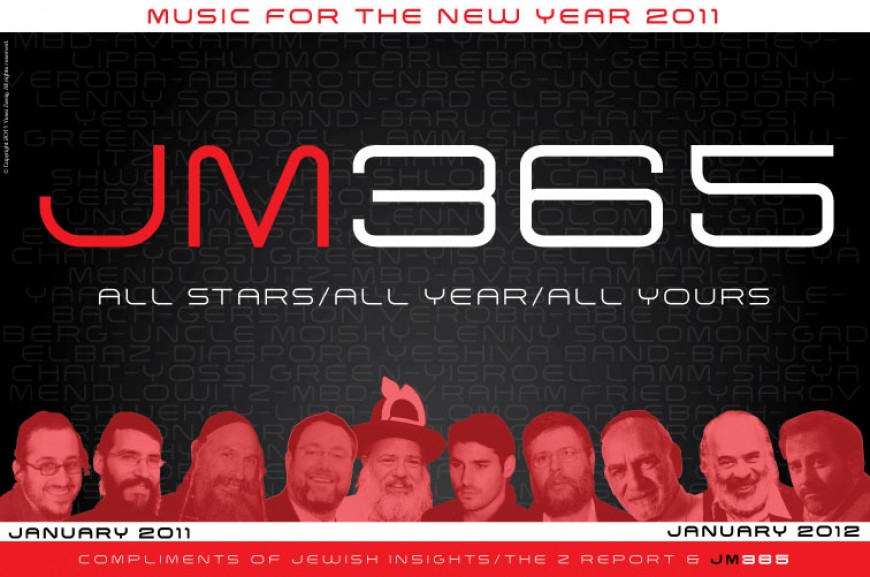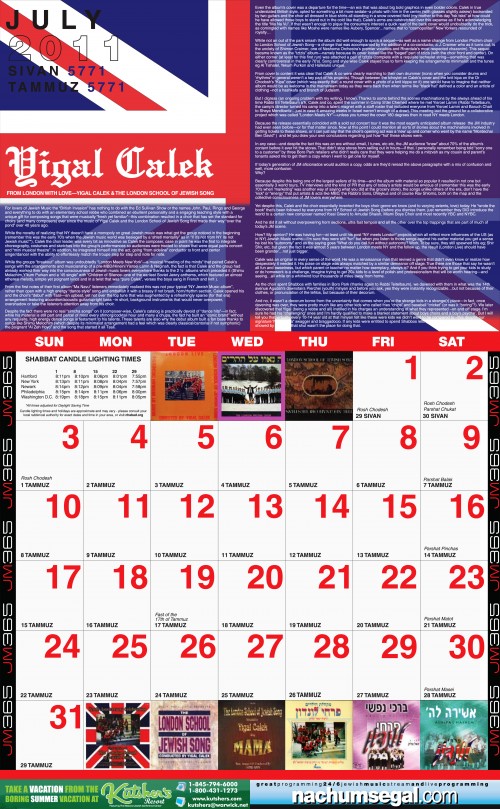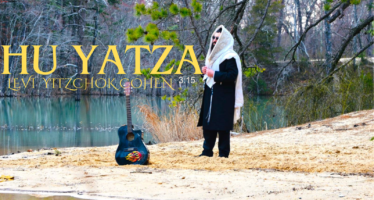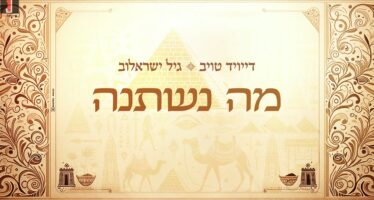JM365 – JULY: ALL STARS/ALL YEAR/ALL YOURS

There’s calendars for lovers of everything from Autos to Zebras…everything that is except Jewish Music. Think about it, why can’t Jewish Music fans have a calendar with 12 months of top stars to enjoy? Well as we couldn’t think of a reason either, we decided to do something about it. So please join us in welcoming (and enjoying) JM/365 the calendar created especially for lovers of Jewish music…and those who love seeing them smile. Its 12 months of everybody’s favorite stars just a click and download away–then ready for printing and displaying on your wall, desk or as a screen saver!
This month in honor of those long summer nights we present Yigal Calek. Did you know Yigal has done more for Jewish music then just bringing us the London School of Jewish Song? Below, in no particular order are Yigal Calek’s contributions to the wonderfully wild world of Jewish music. Here’s my top 12. Yes, I’m sure there’s more, but as I feel this is “geek like” enough, I’m not getting into a song by song analysis (for the most part anyway). If you don’t agree with any or feel I missed some please contact me c/o this website. Until then, here’s my
“CALEK’S TOP 12 CONTRIBUTIONS TO JEWISH MUSIC”
1) Giving It A Sense Of Style Not Just Song—The sketches, choreography etc, all proved that the boys were talented more than just vocally. Speaking of style, he also gave arrangers a chance to stretch their creative wings. Listen to ‘Nichsefa” on LMNY and you’ll hear Clave and other Latin percussion-esque sounds that were clearly part of the arrangement. Calek didn’t have a songwriting style as much as he gave songs he wrote a style.
2) Sensitivity— “Children of Silence” , “Pada”, “Shimu Melachim” and countless others all were “melodically nuanced”, many with 3 or 4 “parts” vs just the typically “high part” “low part” structure plus Calek’s “parts” were almost always pleasantly surprising rather than predictable.
3) The “Mashup Medley” : The group’s concert performances almost always featured a medley—that was actually more like a mashup—as in a group of songs (not always all Calek) that despite varying, tempos, styles and chords would—in Calek’s hands—become magically, memorably malleable…all while becoming even more musical—and kudos as always to Yisroel Lamm as his arrangements would invariably enhance Calek’s vision rather than merely accompany it
4) Choir As The Star—his songs (in the beginning at least) were almost always “sparsly” arranged with instrumentation than would ensure the vocals would never be over powered. This combined with his simple yet layered harmonies made for a listening experience that could be enjoyed on many levels
5) A Sound: “Legend” has it that Calek would only record in certain studios as this would give him the rich yet real choral sound he wanted. Listen to his earlier albums and hear for yourself, there’s a natural resonance and depth to the vocals that years later inspired certain choir leaders (and you know who you are) to seek out those facilities to record/mix certain parts of their projects…with varying results
6) A HASC High Point. When Sheya Mendlowitz announced that Calek was going to be a part of HASC –back when Sheya was still a part of it, initial reaction was raised eyebrows –until Calek together with a new choir took the stage and proved that lighting does in fact sometimes strike twice. Unfortunately a companion “London School” album which reflected a more contemporary musical sensibility didn’t fare as well which proves there is something to “sticking to the script”
7) Dedi: One of Calek’s side projects was the Pierchei Tzabarim a mid 70’s Israel-based choir that tried to recreate the magic of Jolly Old England is Jolly Older Jerusalem, the result which had Calek’s signature fit and finish didn’t resonate with listeners the way his other projects had, though the same couldn’t be said for one of the choir members, as it inspired a grateful Dedi…Graucher, who ultimately used it as a stepping stone to Graucher—uh greater, and louder things
8) Yossi Green; While Yossi Green gave us Yossi Green (feel free to ask him) and despite the fact their styles are to say the least different, (not to mention the fact that Yossi is a way more pertinent and prolific part of the JM world) Green (who met Calek when he was a budding composer/yeshiva student in London) considers these meetings amongst his first “breaks”.
9) The Jewish Concert As A Destination: Before Calek & The School non cantorial concerts were usually “a” thing to do vs “THE” thing to do. Calek and the choir changed all that—a lesson that even decades later wasn’t lost on Sheya Mendlowitz, Ding, Ohel and others.
10) Choirs Are Cool: Pre London Jewish boys choirs either backed up Chazzanim, and/or were used as affordable “home grown” entertainment for shul and yeshiva functions. Calek made it cool for kids to belong to a choir. In fact when Eli Teitelbaum decided to capitalize on “London Fever” by forming a choir (Kol Naim) for a Pesach concert/album. Hundreds of kids (and even more parents) from throughout the 5 boroughs (and parts of NJ) showed up at the Boro Park Y to audition in the hopes of being awarded a slot and really cool pull over sweater vest. That’s right hundreds of kids who were ready to give up the precious little free time they had all for two free tickets and a chance to say “I’m in the choir”. Kol Naim evolved into NY School which partially begat Amudai Shaish whilst in a related story a certain up and coming composer was discovering he could compose songs “the way other people breathe”
11) It’s Not Just About NY. Suddenly NY Jews were taken down a notch, sure we had the best pizza, Kosher King (a predecessor to Kosher Delight –so what if it was in the wilds of Coney Island?), the yeshivas that supplied camps with the coolest counselors, etc etc etc—in one fell swoop we lost our cachet as Jewish music’s entertainment incubator. Ok thanks to MBD, Fried and others we quickly recaptured it, but the fact that the #1 is Jewish music was an import not a domestic made us understand how GM felt when Toyotas started showing up on the road
12) Replacing The Iron Curtain With A Stage Curtain. One of the earliest by products of Glasnost JM-wise, was Calek and the Choir’s 1988 tour of the former Soviet Union. Yes they were preceded by (if memory serves) Shlomo, Sherwood and numerous Rabbanim, but the logistics of a Jewish Boys choir putting on a show stated with certainty that Glasnost was very real. Though one wonders how “Children of Silence” went over?
Be here next month as we take a look at one of artist that really left a “impression” on us.
Click HERE to download both a hi-res .jpeg and .pdf of July.
Click HERE to download January, HERE for February, HERE for March, HERE for April, HERE for May and HERE for June.
Feel free to pass this along to friends and family.
Related Articles
Hu Yatza – Levi Yitzchok Cohen | הוא יצא – לוי יצחק כהן
Menachem Freedman Presents: Thank You Hashem At a time like this it’s so clear that the story of us leaving
David Taub & Gil Yisraelov With A New Single “Mah Nishtana”
After their great hit together with the song Dayenu, David Taub and Gil Yisraelov are releasing a brand new single
The Nechama of Pini Einhorn: A New Single Accompanied By A Rare & Historic AI Video!
At the beginning of the Nisan – a month of redemption and consolation, Pini Einhorn launches the first monumental A.I.





